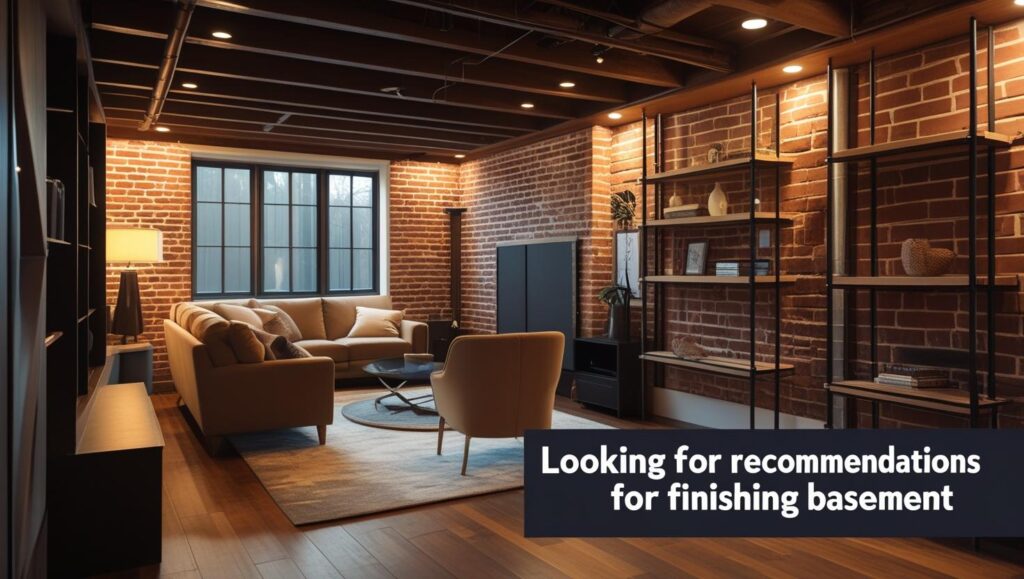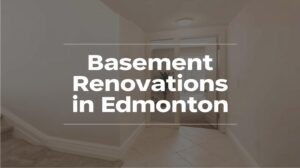Looking for recommendations for finishing basement
Looking for recommendations for finishing basement can become overwhelming very fast when you are confronted with decisions involving layout, design, permits, materials, and budget. You may be thinking of a cozy family room, a rental unit, or a home office. Whatever you have in mind, the choices you make today will determine the quality and usability of your basement for many years to come.
If you’re in the process of planning a basement renovation in Edmonton, you’re far from alone. Lots of house owners in the city are hoping to reinvent their wasted lower levels into living areas with worth. Within this guide, we’ll highlight some of the greatest recommendations to enable you to complete your basement successfully with confidence.
1. Define the Purpose of Your Basement
Before selecting flooring or paint colors, take some time to determine what your completed basement will be utilized for. Some of the most common uses include:
A guest bedroom or suite
A rental apartment
A home recreation room
A home exercise room
A home office
A children’s playroom
A laundry and utility zone
Your final purpose will influence your design choices, from lighting and layout to plumbing and insulation. For instance, a rental property will need an independent entrance and adherence to certain egress and fire codes, but a gym or party room may be concerned more with soundproofing and ventilation.
2. Familiarize Yourself with the Legal Requirements
All basement remodels in Edmonton are subject to local building codes and zoning ordinances. This typically involves the acquisition of proper permits for electrical, plumbing, structural modifications, and general development. Most homeowners ignore this step or think it is only required for extensive remodeling—but not obtaining the permits can cause serious issues down the road, particularly with resale or insurance reimbursement.
In Edmonton, if you intend to include a secondary suite, install new plumbing, increase window size, or relocate structural walls, you need to obtain a permit and get the work inspected. Check with the local permitting office at all times to ensure what your project requires.
3. Invest in Moisture Control and Waterproofing
Moisture is one of the largest threats to any basement. Before a single wall can be framed or flooring installed, your basement must be dry and watertight to prevent future water ingress.
The most important steps are:
Checking for current leaks or signs of water damage
Sealing foundation cracks
Replacing or improving weeping tile or sump pumps
Installing moisture-resistant insulation and vapor barriers
Looking at dehumidifiers for long-term management
Even if your basement seems to be dry, it’s better to get ahead. A few extra precautions during the construction will cost you thousands in repairs down the road.
4. Design Your Layout Strategically
Basements usually have more layout problems than floors upstairs. You are working around foundation walls, HVAC equipment, water tanks, and low ceilings. Intelligent design can assist you in getting the most out of your space.
Here are a couple of tips:
Group bathrooms and laundry facilities close to existing plumbing lines to save money.
Utilize sliding doors or pocket doors to take advantage of scarce square footage.
Design open-concept spaces to create the illusion of more space.
Utilize built-in shelving or under-stair storage to conserve space.
It’s also a good idea to think about flexibility. Your family’s needs may shift in the future, so designing multipurpose spaces can add to the long-term value of your basement.
5. Priority to light and ceiling height
The basement is notorious for being dark or dense. You can fight it with a light and roof plan.
For light:
Install multiple light fixtures: ceiling lights, wall cones and floor lamps.
Use hot white LED bulbs for a natural, comfortable atmosphere.
Install dimmer switches to adjust mood and brightness.
For ceiling height:
If your ceiling is less than 7 feet, you will have to lower the floor (costly) or redo ducting and mechanicals.
Paint the ceiling a light color to give the illusion of height.
Employ low-profile lighting to prevent diminution of headroom.
The design of the exposed roofs (painted black or white) can also be used for an industrial scaffolding with open space.
6. Choose the correct floor
The basement must be able to handle potential moisture, traffic and temperature changes.
Some of the best floors for renovation of Edmonton basement are:
Luxury Vinyl Planck (LVP): Water -repellent, long -lasting and available in many designs.
Tiles: Excellent for washing rooms and bathrooms, even though they are cooling to go to the floor is combined with heat.
Carpet tiles: Easy to establish and replace some in case of malfunction.
Engineer Wood: Provides a more sophisticated look, but requires a dry setting.
The solid hard work is clearly on the wood, which will bother when exposed to moist or moist environment.
7. Invest in sound insulation
If you design a music room or want to minimize the noise between the floor, sound insulation is worth making an investment. There are some ways to reduce the sound:
Planning of acoustic insulation in walls and ceilings
Sound -insulated plaster or flexible channels
Lamp
To seal any location where the sound can travel (eg, channel opening or electric outlet)
For rental housing, sound insulation is especially important for providing privacy and comfort for both tenants and owners.
8. Further plan: energy efficiency and relaxation
A comfortable basement is one that remains warm in winter and cools in the summer. Think about increasing the insulation, the air leakage and reviewing the HVAC system to provide equal temperature control.
Other options are:
Brilliant underfloor heating for tiles or concrete floors
Sonet heating and cooling system
Energy skilled doors and windows
Smart thermostats for more control
These capabilities not only increase comfort, but also increase the long -term energy efficiency of your home.
9. Prepare for the Unexpected
Basement renovations, despite planning, tend to involve surprises—hidden electrical wiring, plumbing issues, or the presence of water behind the walls. A rule of thumb is to earmark 10% to 20% of your overall renovation budget for unexpected situations.
In Edmonton, basement finishing cost can widely fluctuate based on size, configuration, materials, and extent of work. A small DIY project could cost between $30–50 a square foot, whereas a professional reconstruction or legal suite can be much more expensive.
10. Seek Feedback from Other Homeowners
If you want Edmonton-specific advice on completing basement renovations, think about talking to fellow homeowners who’ve recently undergone renovation. You can find people discussing on local forums, neighborhood groups, or renovation posts.
Talking to people who have gone through it first hand regarding budgeting breakdowns, timeline surprises, go-to materials, and reliable subcontractors can provide valuable information beyond what you’d know from general renovation manuals.
Final thoughts
Completing renewal of a basement in Edmonton is a rewarding project that can significantly increase the home and value and value. Whether you are taking on a simple upgrade or developing a completely legal case, each decision allows – from moisture control to layout and lighting.
Plans carefully, understand your legal responsibility and follow smart design principles, you will be well on your way to making a place that provides comfort, task and long -term investment returns.





